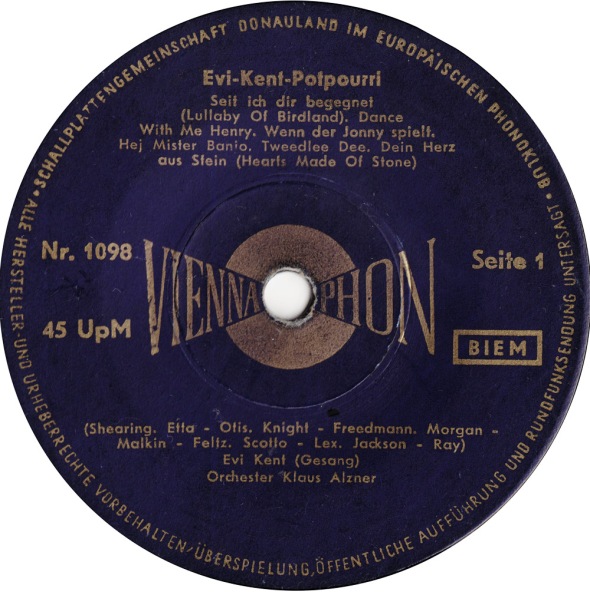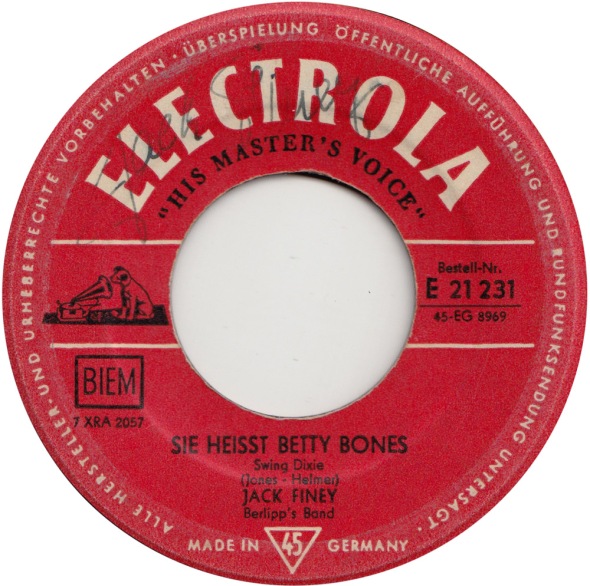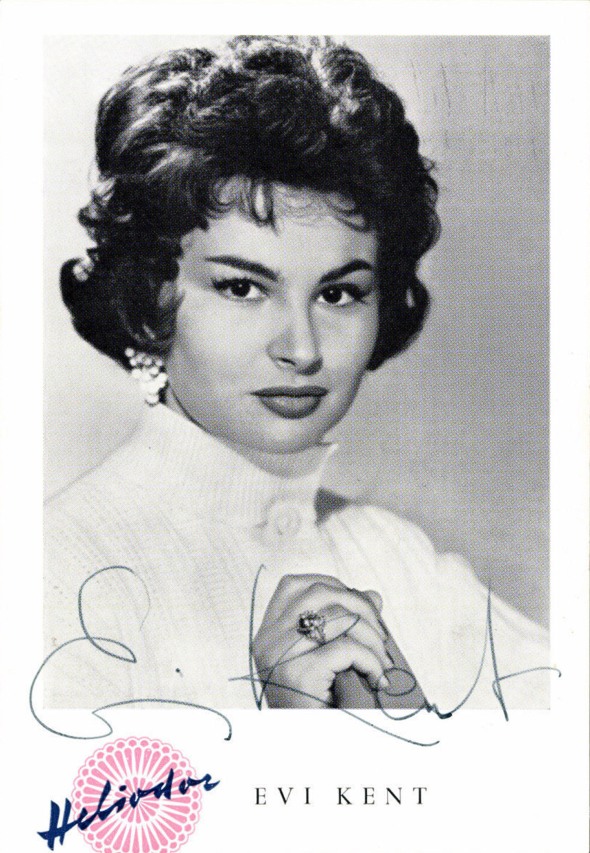ILJA GLUSGAL, Sensation in Dixieland, 1955
Posted: June 11, 2015 Filed under: 50s, Germany 1 Comment ” The only people who like this, are Götz Alzmann and you” my co-host sneered, after I had played this song on our radio show a while back. “I think it´s funny!”, I tried to defend my choice. “I´m shocked. Speechless”, he replied. He obviously hated the song. I said: “Wait, til´ I play my other songs…”.
” The only people who like this, are Götz Alzmann and you” my co-host sneered, after I had played this song on our radio show a while back. “I think it´s funny!”, I tried to defend my choice. “I´m shocked. Speechless”, he replied. He obviously hated the song. I said: “Wait, til´ I play my other songs…”.
I do like obscure, regional German records and, yes, there are reasons, they never got anywhere. But it´s boring to only listen to the records by myself at home. And it´s fun to catapult a local Berlin song into the digital world after 60 years of obscurity.
(Coco Schuhmann, guitar; Rudi Ernst, clarinet; Ilja Glusgal, cymbal; and unidentified woman jammin´ at Wannseebad, 1940; from Schumann´s autobiography „Der Ghetto-Swinger”, 1997)
Ilja Glusgal was born to Jewish and non-Jewish parents (according to his friend, jazz guitarist Coco Schuhmann) and went to music school when he was 9 years old, to learn to play piano and violin. His first professional job was as a drummer in the swing band of Lubo d´ Orio in 1942, when he was 21. In 1946, he joined the new RBT-Orchestra ( Radio Berlin Tanzorchester), where his talent as a vocalist was “discovered” by Michael Jary. Handsome Ilja quickly became one of the first stars of the post-WWII-era and appeared in eleven movies. By 1950 he had recorded two dozen sides for the state-owned communist East-German Amiga label, but also for West-German labels Columbia, Electrola, HMV, Metrophon, Odeon, Parlophone and Regina. Glusgal even recorded a promotional shellack record for the German beer company Bitburger:”Bitte ein Bit”. His last seven singles of his short career were issued by Philips. Around 1955 he settled in the United States and seems to have stopped working in the music business for good. Apart from an appearance in a German TV-show in 1964, his later life is a mystery. Ilja Glusgal died in 1983 in San Francisco, California.
Ilja Glusgal was the most American of German post-war swing vocalists, if not all Schlager vocalists ever. From Louis Prima´s Bananas and “Angelina, to Jeepers Creepers , to Sensation am Broadway, a German Version of Lullay of Broadway, he always tried to keep it swingin´. He even recorded two western-swing songs in 1949: Roy Rogers´ I’m An Old Cow-Hand and Peter de Vries´ Cowboy Jimmy.
Sensation in Dixieland, backed by Lutz Albrecht and his orchestra and accompanied by the Continentals vocal group, must have been one of Glusgal´s last recordings. His genuine love for jazz music still shines through, though largely overshadowed by Schlager. This lack of purity is one reason it has not been reissued in 60 years.
I hope I´m not the only one to like this type of Swing-Schlager….
ILJA GLUSGAL, Sensation in Dixieland
Ilja says”Prost!” and goes to play the drums. He´s seen to the right of Lonny Keller. From the film “Die Blume von Hawaii” (1953):
Again he plays the drums in the film “Grosse Starparade” (1954):
JAZZ MEETING mit den Spree City Stompers, 1958
Posted: February 28, 2015 Filed under: 50s, Berlin Records, Germany, Jazz Records 1 CommentTrombonist Hans-Wolf “Hawe” Schneider (1930 – 2011) formed the Spree City Stompers, who became one of the most popular German trad jazz bands, in 1951. Two years later he also opened the legendary “Eierschale”, along with “Badewanne”, the best German Jazz clubs. Louis Armstrong, Ella Fitzgerald, Duke Ellington and Kid Ory appeared at “The Eggshell”. A website dedicated to the cellar pub is here.
The Spree City Stompers first recorded with Brunswick in 1955, then got picked up by the German Vogue label. They also cut a 10″ album “Jazz aus der Eierschale”, together with “Wild” Bill Davison for the budget Bertelsmann/Manhattan label. They toured Western Europe, Poland, Yugoslavia and Africa, appeared in films and on TV and hit the German charts twice in 1961 with “Warte, warte nur ein Weilchen”, a black humored song that dealt with the 1920´s serial killer Fritz Haarmann, and “Brigitte Bardot”. The band dissolved in 1968, when Hawe Schneider moved to the Black Forest region. He stayed active in the jazz scene, his last performance being with the Black Forest Jazz Band in 2007.
After their Brunswick recordings and before their Vogue deal, the Spree City Stompers recorded this EP for Opera in 1958. It has never been re-released in any format.
Hot Jazz from Berlin!
SPREE CITY STOMPERS, My Gal Sal, 1958
SPREE CITY STOMPERS, Old Stack O´Lee Blues, 1958
SPREE CITY STOMPERS, Ain´t Misbehavin´ , 1958
SPREE CITY STOMPERS, St. Louis Blues, 1958
The Spree City Stompers were: Hawe Schneider (tb), Peter Strohkorb (cl), Gerd Vohwinkel (tp), Björn Jensen (bj), Martin Piepkorn (p), Tilo Wendell (bs and sousaphon) and Udo Künitz (d).
Within a short time they appeared in seven Films: Der Himmel ist nie ausverkauft (1955), Der Schräge Otto (1957), Einmal eine große Dame sein (1957), Liebe, Jazz und Übermut (1957), Meine 99 Bräute (1958), … und noch frech dazu (1960) and Verrückt und zugenäht (1962)
In 1957, the Spree City Stompers also show up in the awesome kitsch-masterpiece Der schräge Otto (Fritz Schulz-Reichel, alias Crazy Otto), backing Nana Gualdi and Eddie Pauly and a bunch of Boogie Woogie dancers:
This footage of the Spree City Stompers in Berlin, was shot to promote their extensive tour of Africa in 1966. The silent Super 8 film was dubbed and uploaded by the son of the group´s drummer Lothar Scharf:
Hawe Scheider also wrote for Jazz magazines, such as the local “Schlagzeug” (drums). From February 1959:
LUBO D´ORIO UND SEINE ROCK´N´ROLL-BAND, Ausser Rand und Band, 1956
Posted: February 27, 2015 Filed under: 50s, Berlin Records, Germany, Rock´n´Roll Records Leave a comment


 Jazz musicians of the swing era, like Count Basie, Sy Oliver and Lionel Hampton all dabbled in rhythm & blues and early rock´n´roll, maintaining the close link of jazz and dance music into the 1950s. Largely to no avail, both jazz and rock´n´roll fans dismissed their efforts as commercial.
Jazz musicians of the swing era, like Count Basie, Sy Oliver and Lionel Hampton all dabbled in rhythm & blues and early rock´n´roll, maintaining the close link of jazz and dance music into the 1950s. Largely to no avail, both jazz and rock´n´roll fans dismissed their efforts as commercial.
In 1956, the prolific Berlin swing-orchestra leader Lubo D´Orio (1904-1983) recorded two boogie and rock´n´roll EPs for the Opera record-club label. I posted the Boogie EP three years ago, but just a while back I also found his other Opera EP in a local charity shop.
This EP features five tracks from the film Rock Around The Clock starring Bill Haley and Freddy Bell and his Bellboys. While never re-released in any format, the tracks are fairly well known among German rock´n´roll collectors, but because they fall in-between big band swing and rock´n´roll, have largely been neglected or even ridiculed as second-rate rock. They´re too rockin´ for the swing fans and too swingin´ for the rockers.
Apparently not much has changed in the evaluation of this budget record in the past 60 years, even down to the price: I paid one Euro.
Whatever…
I love it!
LUBO D´ORIO UND SEINE ROCK´N´ROLL-BAND, Rock Around The Clock (“Wenn der Jonny spielt”), 1956
LUBO D´ORIO UND SEINE ROCK´N´ROLL-BAND, Rock a beatin´ Boogie, 1956
LUBO D´ORIO UND SEINE ROCK´N´ROLL-BAND, Happy Baby, 1956
LUBO D´ORIO UND SEINE ROCK´N´ROLL-BAND, A-B-C Boogie – Mambo Rock, 1956
LUBO D´ORIO UND SEINE ROCK´N´ROLL-BAND, Teach you to Rock – Giddy-up a Ding-Dong, 1956
ALEXANDER GORDAN, Heut´ tanz ich nur mit dir, 1959
Posted: February 26, 2015 Filed under: 50s, Berlin Records, Germany, Rock´n´Roll Records Leave a comment


 Whenever I see one of those purple Opera sleeves in a record store, I stop to take a closer look. Over the years I´ve posted ten of these record-club 45s. With this one, I also immediately recognized the name. Alexander Gordan recorded a cover of Vico Torriani´s “Schwarzer Domino“, released by local super-budget flexi-disc label Okay Exquisit, that I posted back in 2008
Whenever I see one of those purple Opera sleeves in a record store, I stop to take a closer look. Over the years I´ve posted ten of these record-club 45s. With this one, I also immediately recognized the name. Alexander Gordan recorded a cover of Vico Torriani´s “Schwarzer Domino“, released by local super-budget flexi-disc label Okay Exquisit, that I posted back in 2008
Alexander Gordan (1926-2008) was a busy bee in the burgeoning Berlin pop-market of the 1950s and 60s. Early in his career, he performed as a bass-vocalist in various small groups, tried to go solo in the late 50s, but eventually was more successful as a song writer. His first big break was writing the lyrics to the German cover version of Pat Boone´s “Speedy Gonzales”. Rex Gildo reached #1 in the German charts in 1962 with his version, alongside Boone´s. Gordan also recorded his own version for Opera.
The Opera record club mostly put out cover songs, but occasionally an original song slipped through. Alexander Gordan´s “Heut´ tanz ich nur mit dir” was exclusively issued for Opera – Europäischer Phonoklub.
It went by unnoticed and has not been re-released in any format since 1959.
Undeservedly so. It´s a nice little rocker…
ALEXANDER GORDAN, Heut´ tanz ich nur mit dir, 1959

 Alexander Gordan wrote for artists like Gerd Böttcher, Caterina Valente and Suzanne Doucet, my favorite being”I Like Jimmy” from 1964, for the duo The Chicks. It was the flip to Ich Will Deine Liebe, the German version of the Dixie Cups #1 smash “Chapel Of Love”. I couldn´t find “I Like Jimmy” online, so I might post it some other time. It´s great up-tempo schlager-beat.
Alexander Gordan wrote for artists like Gerd Böttcher, Caterina Valente and Suzanne Doucet, my favorite being”I Like Jimmy” from 1964, for the duo The Chicks. It was the flip to Ich Will Deine Liebe, the German version of the Dixie Cups #1 smash “Chapel Of Love”. I couldn´t find “I Like Jimmy” online, so I might post it some other time. It´s great up-tempo schlager-beat.
In 1975, Gordan´s career took a bizarre turn when he recorded under the pseudonym Detlev. Singing in an effeminate faux-gay style, Gordan released eight 45s and three LPs of mostly covers of hit-songs. These parody-records were quite successful, simply because they ridiculed gay people. The gay scene was not amused…
SIDNEY BECHET, Spirit Holiday, 1958
Posted: December 18, 2014 Filed under: 50s, France, Jazz Records 4 Comments


 Sidney Bechet recorded these four Christmas songs on December 10 and 12, 1958, accompanied by Jean-Claude Pelletier, organ, Claude Gousset, trombone, Alix Bret, bass and Kansas Fields on drums. Less than six month later, Sidney Bechet died in Paris from lung cancer on May 14, 1959, on his 62nd birthday.
Sidney Bechet recorded these four Christmas songs on December 10 and 12, 1958, accompanied by Jean-Claude Pelletier, organ, Claude Gousset, trombone, Alix Bret, bass and Kansas Fields on drums. Less than six month later, Sidney Bechet died in Paris from lung cancer on May 14, 1959, on his 62nd birthday.
While these Holiday tunes might not be considered cream of the crop by some jazz fans, Sidney Bechet did not record a bad song in his lifetime. He even pulled off a spirited version of White Christmas….
SIDNEY BECHET, Spirit Holiday, 1958
SIDNEY BECHET, Blues du Papa Noel, 1958
SIDNEY BECHET, Silent Night, 1958
SIDNEY BECHET, White Christmas, 1958
EVI KENT, Evi-Kent-Potpourri, 1956
Posted: December 3, 2014 Filed under: 50s, Austria, Rock´n´Roll Records 2 Comments
 Ella Fitzgerald , Etta James and LaVern Baker together on one side of this 45! In the mid-50s, Austrian actress Evi Kent recorded a medley of German versions of Lullaye Of Birdland, Dance With Me Henry and Tweedle Dee for the Viennaphon label.
Ella Fitzgerald , Etta James and LaVern Baker together on one side of this 45! In the mid-50s, Austrian actress Evi Kent recorded a medley of German versions of Lullaye Of Birdland, Dance With Me Henry and Tweedle Dee for the Viennaphon label.
Also included in the mix is Wenn der Johnny spielt, a German version of Rock Around The Clock, first recorded by Svend Asmussen, and Dein Herz aus Stein, a German version of Hearts Made Of Stone, originally recorded by Otis Williams & His Charms in 1954, but more likely based on the white covers by Georgia Gibbs and the Fontane Sisters.
The love metaphors of “Lullaby of Birdland, that’s what I/ always hear/ when you sigh” were further modified to fit a more realistic Austrian setting. “Seit ich dir begegnet/ geh ich froh/ jeden Tag/ ins Büro”: Since I met you, I´m happy to go to work every day.
Found on a rainy Sunday in Vienna at the Naschmarkt- flea market. Apparently it´s never been re-issued in the past sixty years…
German version of Alma Cogan´s 1954 duet with Frankie Vaughan “Do, Do, Do, Do, Do, Do It Again”
MARGRIT SOERENSEN, Du bist mein Typ (Do It Again)
MARGRIT SOERENSEN, Kennen Sie den Mann? (Have You Seen My Love)
JACK FINEY, Sie heisst Betty Bones, 1959
Posted: November 4, 2014 Filed under: 50s, Germany, Rock´n´Roll Records 6 Comments
 The story of Afro-Caribbean artists working in Germany in the 1950s, has not been written yet. After the second World War, musicians like Roberto Blanco (Cuba), Mona Baptiste (Trinidad), Billy Mo (Trinidad) and Jack Finey (Curaçao) helped to transform German culture and society. From a despised and isolated country, that had caused the worst crimes of the century, back into the civilized world. Germans simply couldn´t have lifted themselves out of their misery. As you will hear, they needed the help of some spirited Caribbeans desperately.
The story of Afro-Caribbean artists working in Germany in the 1950s, has not been written yet. After the second World War, musicians like Roberto Blanco (Cuba), Mona Baptiste (Trinidad), Billy Mo (Trinidad) and Jack Finey (Curaçao) helped to transform German culture and society. From a despised and isolated country, that had caused the worst crimes of the century, back into the civilized world. Germans simply couldn´t have lifted themselves out of their misery. As you will hear, they needed the help of some spirited Caribbeans desperately.
Unfortunately, information about Jack Finey is scarce. At least, the trusty German Rock´n´Roll-Schallplattenforum, collected a bit:
Jack Finey (born Jakob Frerian Christian Schreuder) was born in Amsterdam in 1928. He grew up in Curaçao and returned to Amsterdam when he was 14 years old. He appeared on Broadway. In 1959 he first recorded in Germany for Electrola and later Decca, also for the Austrian Amadeo label in 1962 and for German Vogue label in 1967. In 1960 Jack Finey appeared in the German musical comedy “Meine Nichte tut das nicht” with his song Schade um die Rosen.
In 1959 Jack Finey recorded this fine two-sider for Electrola, containing German versions of Louis Prima´s “The Closer To The Meat” and Lloyd Price´s “Stagger Lee”.
Like other popular American folk songs, such as Delia Gone, Stagger Lee is a song about an actual murder case. In 1895, “Stag” Lee Shelton, a black pimp, shot Billy Lyons in St. Louis, Missouri, over an argument about politics. Lyons snatched Shelton´s hat from his head. Stagger Lee demanded it back. When Billy refused, Stagger Lee shot him, took his hat and walked away. Shelton was arrested and convicted of murder in 1897. The crime quickly entered into American folklore and became the subject of songs.
In 1928, Mississippi John Hurt recorded the most well-known blues version of Stagger Lee. Twenty-two years later, New Orleans rhythm & blues pianist Archibald wrote and recorded his own version of Stack A Lee. It´s a New Orleans boogie in an easygoing, rocksteady rhythm, that is very well worth listening to on Youtube. The Imperial 45 has two parts. In Part 2, Stagger Lee dies and goes to the devil. Lloyd Price covered Archibald´s “Stagger Lee Part 1” and turned it into a # 1 hit on the Billboard charts in 1959.
Whereas the lyrics of German versions of US hits were usually changed completely, and left only the melody intact, the German lyrics to “Stagger Lee” are unusually faithful to the original. They´ve got pretty much the exact meaning and content, down to naming the song ” Die Geschichte von Stagger Lee” (The story of Stagger Lee). The German writer Nicolas sure had a good instinct for teenage subjects. Whereas Dick Clark reportedly had Lloyd Price change the lyrics to a fight over a woman and a happy ending, to appear on his show, the German lyrics keep the bloody ending.
Just for comparison, I transcribed the lyrics. The lines change from German to English, to make the song more authentic. Note the Dutch accent in “He´s real danger!”:
“Ich stand müde an der Ecke,/ doch ich bin dann plötzlich aufgewacht./Auf der Strasse würfelten zwei Männer in der Nacht./ Da war Stagger Lee, da Billy,/ da die Würfel, um Mitternacht./ Stagger Lee warf eine Sieben,/ Billy schwor, er habe acht./ Stagger Lee sagte heiser,/ lass das Zeug , Mensch. Ich habe ´ne Wut./ Du hast all mein Geld gewonnen/ und auch meinen neuen Hut./ Stagger Lee ging nach Hause,/ schob ´ne Kugel in den Lauf./ Sagt, die Schuld muss ich begleichen/ und entsicherte darauf./ Watch out! Watch Out, Billy! Watch out for Stagger Lee, man. He´s real danger, man! He´s real danger! Be careful, Billy! Run, Billy, Run! That´s the only thing you can do!/ Zu der Bar ging er heimlich,/ und dann stand er grinsend in der Tür./Zog den Colt und sagt zu Billy:/ “Büssen musst du mir dafür!”/ “Stagger Lee!”, rief Billy./ “Schon mein Leben. Nehm´ es nicht./ Denk an meine kleinen Kinder./ Meiner Frau, das Herz zerbricht.”/ Stagger Lee schoss auf Billy./ Nahm ihm alles, was er besass./ Und die Kugel flog durch Billy/ und zerbrach ein Whiskeyglas./ Run, run, Stagger Lee, lauf! That´s the only thing you can do. Lauf, Stagger Lee! You´re a bad boy! You´re really bad, man! Look at that poor Billy, laying on the floor, guy. Oh, he´s dead. Billy is dead.You´re bad… Run, run...”
JACK FINEY, Die Geschichte von Stagger Lee, 1959
“Betty Bones” is the German version of Louis Prima´s saucy The Closer To The Bone, of his 1959 album “The Call Of The Wildest”.
“Now she’d make a good thermometer/ If she drank a glass of wine/ She’s built just like a garter snake/ She climbs up like a vine/ My friends tell me I’m a fool/ To love a girl like that/ Here’s the reason I like ’em slim/ Instead of big and fat/ ‘Cause closest to the bone/ Sweeter is the meat/ Last slice of Virginia ham/ Is the best that you can eat”
Bony Moronie. Long Tall Sally. Skinnie Minnie. The list of songs about skinny girls is long in pop music, from the 1920s into the 1960s, equally long as the list about fat girls. Today they would be considered rude, except in rap songs. Now, in the German version, only the title “Betty Bones”, touches on the subject of skinny girls. “Sie heisst Betty Bones” is about a girl with a cold heart, or at least she´s not into Jack, until she get´s jealous of another girl…
Just here….
JACK FINEY, Sie heisst Betty Bones, 1959
Side note: When I bought this 45, last week in a local second-hand record store for four Euros, I didn´t see that the record was autographed.Until I scanned the record and suddenly saw the label in high-resolution. Compared with the signatures on these two autographed pictures that are currently offered on Ebay, they look pretty similar. That little loop over the F gives it away.
The seller in the record store sure didn´t see the signature either, otherwise the record probably wouldn´t have been so cheap.
THE ACCORDIONAIRES, Accordeon Rock and Roll
Posted: October 24, 2014 Filed under: 50s, Rock´n´Roll Records, USA Leave a comment
 In the 1950s, Rock´n´Roll was a force. Some brave accordionists were still holding their ground, not ready to give up the fight. But it was a losing game, loud electric guitars were taking the world by storm. Since then, they have more or less replaced acoustic instruments like accordions, recorders, zithers, cazoos and washboards in popular music.
In the 1950s, Rock´n´Roll was a force. Some brave accordionists were still holding their ground, not ready to give up the fight. But it was a losing game, loud electric guitars were taking the world by storm. Since then, they have more or less replaced acoustic instruments like accordions, recorders, zithers, cazoos and washboards in popular music.
The Accordionnaires, on the other hand, tried to go with the times…
THE ACCORDIONNAIRES, Accordeon Rock
THE ACCORDIONNAIRES, Accordeon Roll
Found this Rose Records 45 in Vienna a couple of weeks ago. No idea when or where it was published. No trace of it in the digital world either. Obviously it´s never been reissued. About the only thing that popped up, when I searched for The Accordionaires on the Internet, was this music book.

















 About me:
My name is Andreas Michalke. I´m a cartoonist from Berlin, Germany and I like collecting records. Most of the records I find in thrift stores or at flea markets here in Berlin. I like a lot of music but I thought I`d focus on odd German records. Preferably with cartoon covers.
All my scans are high-resolution. If you double-click on them they will get much bigger.
About me:
My name is Andreas Michalke. I´m a cartoonist from Berlin, Germany and I like collecting records. Most of the records I find in thrift stores or at flea markets here in Berlin. I like a lot of music but I thought I`d focus on odd German records. Preferably with cartoon covers.
All my scans are high-resolution. If you double-click on them they will get much bigger.
Recent Comments